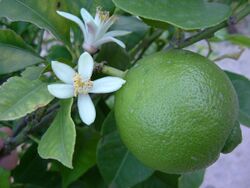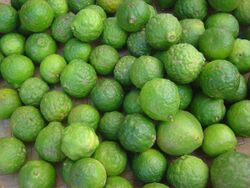Biology:Lime (fruit)


A lime is a citrus fruit, which is typically round, green in color, 3–6 centimetres (1.2–2.4 in) in diameter, and contains acidic juice vesicles.[1]
There are several species of citrus trees whose fruits are called limes, including the Key lime (Citrus aurantiifolia), Persian lime, Makrut lime, calamansi limes, finger limes, blood limes, limequats, and desert lime. Limes are a rich source of vitamin C, are sour, and are often used to accent the flavours of foods and beverages. They are grown year-round.[2] Plants with fruit called "limes" have diverse genetic origins; limes do not form a monophyletic group. The term lime originated in other languages (from French lime, from Arabic līma, from Persian līmū, "lemon")[3]
Plants known as "lime"
The difficulty in identifying exactly which species of fruit are called lime in different parts of the English-speaking world (and the same problem applies to synonyms in other European languages) is increased by the botanical complexity of the citrus genus itself, to which the majority of limes belong. Species of this genus hybridise readily, and it is only recently that genetic studies have started to shed light on the structure of the genus. The majority of cultivated species are in reality hybrids, produced from the citron (Citrus medica), the mandarin orange (Citrus reticulata), the pomelo (Citrus maxima) and in particular with many lime varieties, the micrantha (Citrus hystrix var. micrantha).
- Australian limes (former Microcitrus and Eremocitrus)
- Australian desert lime (Citrus glauca)
- Australian finger lime (Citrus australasica)
- Australian lime (Citrus australis)
- Blood lime (red finger lime × (sweet orange × mandarin))
- Makrut lime (Citrus hystrix); a papeda relative, is one of the three most widely produced limes globally.[4]
- Key lime (Citrus × aurantiifolia=Citrus micrantha × Citrus medica[5]) is also one of the three most widely produced limes globally.[4]
- Philippine lime (Citrus × microcarpa), a kumquat × mandarin hybrid
- Persian lime (Citrus × latifolia) a key lime × lemon hybrid, is the single most widely produced lime globally, with Mexico being the largest producer.[4]
- Rangpur lime (Mandarin lime, lemandarin,[6] Citrus limonia), a mandarin orange × citron hybrid
- Spanish lime (Melicoccus bijugatus); not a citrus
- Sweet lime etc. (Citrus limetta, etc.); several distinct citrus hybrids
- Wild lime (Adelia ricinella); not a citrus
- Wild lime (Zanthoxylum fagara); not a citrus
- Limequat (lime × kumquat)
Note that the tree species known in Britain as lime trees (Tilia sp.), called linden or basswood in other dialects of English, are broadleaf temperate plants unrelated to the citrus fruits.
History
| Country | Production (millions of tonnes) |
|---|---|
| 3.5 | |
| 2.9 | |
| 2.6 | |
| 1.6 | |
| 1.5 | |
| 1.4 | |
| World | 20.8 |
| * includes limes and lemons reported to FAOSTAT Source: FAOSTAT of the United Nations[7] | |
| Error creating thumbnail: Unable to save thumbnail to destination Limes, whole and in cross section | |
| Nutritional value per 100 g (3.5 oz) | |
|---|---|
| Energy | 126 kJ (30 kcal) |
10.5 g | |
| Sugars | 1.7 g |
| Dietary fiber | 2.8 g |
0.2 g | |
0.7 g | |
| Vitamins | Quantity %DV† |
| Thiamine (B1) | 3% 0.03 mg |
| Riboflavin (B2) | 2% 0.02 mg |
| Niacin (B3) | 1% 0.2 mg |
| Pantothenic acid (B5) | 4% 0.217 mg |
| Vitamin B6 | 4% 0.046 mg |
| Folate (B9) | 2% 8 μg |
| Vitamin C | 35% 29.1 mg |
| Minerals | Quantity %DV† |
| Calcium | 3% 33 mg |
| Iron | 5% 0.6 mg |
| Magnesium | 2% 6 mg |
| Phosphorus | 3% 18 mg |
| Potassium | 2% 102 mg |
| Sodium | 0% 2 mg |
| Other constituents | Quantity |
| Water | 88.3 g |
| |
| †Percentages are roughly approximated using US recommendations for adults. Source: USDA Nutrient Database | |
Most species and hybrids of citrus plants called "limes" have varying origins within tropical Southeast Asia and South Asia. They were spread throughout the world via migration and trade. The makrut lime, in particular, was one of the earliest citrus fruits introduced to other parts of the world by humans. They were spread into Micronesia and Polynesia via the Austronesian expansion (c. 3000–1500 BCE).[8] They were also later spread into Middle East, and the Mediterranean region via the spice trade and the incense trade routes from as early as ~1200 BCE.[9][1]
To prevent scurvy during the 19th century, British sailors were issued a daily allowance of citrus, such as lemon, and later switched to lime.[10] The use of citrus was initially a closely guarded military secret, as scurvy was a common scourge of various national navies, and the ability to remain at sea for lengthy periods without contracting the disorder was a huge benefit for the military. British sailors thus acquired the nickname "Limey" because of their use of limes.[11]
Production
In 2021, world production of limes (combined with lemons for reporting) was 20.8 million tonnes, led by India, Mexico, and China as the major producers (table).
Uses
Culinary

Limes have higher contents of sugars and acids than lemons do.[1] Lime juice may be squeezed from fresh limes, or purchased in bottles in both unsweetened and sweetened varieties. Lime juice is used to make limeade, and as an ingredient (typically as sour mix) in many cocktails.
Lime pickles are an integral part of Indian cuisine, especially in South India. In Kerala, the Onam Sadhya usually includes either lemon pickle or lime pickle. Other Indian preparations of limes include sweetened lime pickle, salted pickle, and lime chutney.
In cooking, lime is valued both for the acidity of its juice and the floral aroma of its zest. It is a common ingredient in authentic Mexican, Vietnamese and Thai dishes. Lime soup is a traditional dish from the Mexican state of Yucatan. It is also used for its pickling properties in ceviche. Some guacamole recipes call for lime juice.
The use of dried limes (called black lime or limoo) as a flavouring is typical of Persian cuisine, Iraqi cuisine, as well as in Eastern Arabian cuisine baharat (a spice mixture that is also called kabsa or kebsa).
Key lime gives the character flavoring to the American dessert known as Key lime pie. In Australia, desert lime is used for making marmalade.
Lime is an ingredient in several highball cocktails, often based on gin, such as gin and tonic, the gimlet and the Rickey. Freshly squeezed lime juice is also considered a key ingredient in margaritas, although sometimes lemon juice is substituted. It is also found in many rum cocktails such as the daiquiri, and other tropical drinks.
Lime extracts and lime essential oils are frequently used in perfumes, cleaning products, and aromatherapy.

Nutrition and phytochemicals
Raw limes are 88% water, 10% carbohydrates and less than 1% each of fat and protein (table). Only vitamin C content at 35% of the Daily Value (DV) per 100 g serving is significant for nutrition, with other nutrients present in low DV amounts (table). Lime juice contains slightly less citric acid than lemon juice (about 47 g/L), nearly twice the citric acid of grapefruit juice, and about five times the amount of citric acid found in orange juice.[12]
Lime pulp and peel contain diverse phytochemicals, including polyphenols and terpenes.[13]
Toxicity
Contact with lime peel or lime juice followed by exposure to ultraviolet light may lead to phytophotodermatitis,[14][15][16] which is sometimes called margarita photodermatitis[17][18] or lime disease[19] (not to be confused with Lyme disease). Bartenders handling limes and other citrus fruits while preparing cocktails may develop phytophotodermatitis.[20]
A class of organic chemical compounds called furanocoumarins are reported to cause phytophotodermatitis in humans.[21] Limes contain numerous furanocoumarin compounds, including limettin (also called citropten), bergapten, isopimpinellin, xanthotoxin (also called methoxsalen), and psoralen.[22][23] Bergapten appears to be the primary furanocoumarin compound responsible for lime-induced phytophotodermatitis.[22][23]
Lime peel contains higher concentrations of furanocoumarins than lime pulp (by one or two orders of magnitude),[22][23] and so lime peels are considerably more phototoxic than lime pulp.
See also
- Limeade
- Lime production in Mexico
- List of citrus fruits
- List of culinary fruits varieties
References
- ↑ 1.0 1.1 1.2 "Lime". Encyclopædia Britannica, Inc.. 2016. https://www.britannica.com/plant/lime.
- ↑ Rotter, Ben. "Fruit Data: Yield, Sugar, Acidity, Tannin". http://www.brsquared.org/wine/CalcInfo/FruitDat.htm.
- ↑ Company, Houghton Mifflin Harcourt Publishing. "The American Heritage Dictionary entry: lime". https://www.ahdictionary.com/word/search.html?q=lime.
- ↑ 4.0 4.1 4.2 Plattner, Kristy (26 September 2014). "Fresh-Market Limes". USDA Economic Research Service. http://www.ers.usda.gov/media/1679187/fresh-market-limes-special-article.pdf.
- ↑ Curk, Franck; Ancillo, Gema; Garcia-Lor, Andres; Luro, François; Perrier, Xavier; Jacquemoud-Collet, Jean-Pierre; Navarro, Luis; Ollitrault, Patrick (2014). "Next generation haplotyping to decipher nuclear genomic interspecific admixture in Citrus species: analysis of chromosome 2". BMC Genetics 15: 152. doi:10.1186/s12863-014-0152-1. PMID 25544367.
- ↑ "Australian Blood Lime". homecitrusgrowers.co.uk. http://www.homecitrusgrowers.co.uk/australiannativecitrus/bloodlime.html.
- ↑ "Production of limes and lemons in 2021, Crops/Regions/World list/Production Quantity (pick lists)". UN Food and Agriculture Organization, Corporate Statistical Database (FAOSTAT). 2022. https://www.fao.org/faostat/en/#data/QCL.
- ↑ Blench, R.M. (2005). "Fruits and arboriculture in the Indo Pacific region". Bulletin of the Indo-Pacific Prehistory Association 24: 31–50. https://www.researchgate.net/publication/255579031.
- ↑ "Genomics of the origin and evolution of Citrus". Nature 554 (7692): 311–316. February 2018. doi:10.1038/nature25447. PMID 29414943. Bibcode: 2018Natur.554..311W.
- ↑ Lewis, HE (3 February 1971). "State of knowledge about scurvy". Proc. R. Soc. Med. 65 (1): 39–42. PMID 4552518.
- ↑ "Limey". Oxford Dictionaries. Oxford University Press. http://oxforddictionaries.com/definition/Limey.
- ↑ "Quantitative Assessment of Citric Acid in Lemon Juice, Lime Juice, and Commercially-Available Fruit Juice Products". Journal of Endourology 22 (3): 567–70. 2008. doi:10.1089/end.2007.0304. PMID 18290732.
- ↑ "Evaluation of Citrus aurantifolia peel and leaves extracts for their chemical composition, antioxidant and anti-cholinesterase activities". J Sci Food Agric 92 (15): 2960–67. 2012. doi:10.1002/jsfa.5708. PMID 22589172.
- ↑ Gross, T. P.; Ratner, L.; de Rodriguez, O.; Farrel, K. P.; Israel, E. (1987). "An outbreak of phototoxic dermatitis due to limes". Am J Epidemiol 125 (3): 509–514. doi:10.1093/oxfordjournals.aje.a114557. PMID 3812457.
- ↑ Kung, A. C.; Stephens, M. B.; Darling, T (2009). "Phytophotodermatitis: Bulla formation and hyperpigmentation during spring break". Mil. Med. 174 (6): 657–661. doi:10.7205/MILMED-D-01-7208. PMID 19585784. https://academic.oup.com/milmed/article-pdf/174/6/657/21615087/milmed-d-01-7208.pdf.
- ↑ Hankinson, Andrew; Lloyd, Benjamin; Alweis, Richard (2014). "Lime-induced phytophotodermatitis". J Community Hosp Intern Med Perspect 4 (4): 25090. doi:10.3402/jchimp.v4.25090. PMID 25317269.
- ↑ Riahi, Ryan R.; Cohen, Philip R.; Robinson, Floyd W.; Gray, James M. (June 2009). "What Caused The Rash On This Man's Wrist And Hand?". The Dermatologist 11 (6). http://www.the-dermatologist.com/content/what-caused-this-rash-on-this-man%E2%80%99s-wrist-and-hand.
- ↑ Abramowitz, Alan I.; Resnik, Kenneth S.; Cohen, Kenneth R. (1993). "Margarita Photodermatitis". New England Journal of Medicine 328 (12): 891. doi:10.1056/NEJM199303253281220. PMID 8441448.
- ↑ Weber, Ian C; Davis, Charles P; Greeson, David M (1999). "Phytophotodermatitis: The other 'lime' disease". The Journal of Emergency Medicine 17 (2): 235–237. doi:10.1016/s0736-4679(98)00159-0. ISSN 0736-4679. PMID 10195477.
- ↑ L. Kanerva (2000). Handbook of Occupational Dermatology.. Springer. p. 318. ISBN 978-3-540-64046-2. https://books.google.com/books?id=ZrclHh9Ep7AC&pg=PA318.
- ↑ McGovern, Thomas W.; Barkley, Theodore M. (2000). "Botanical Dermatology". The Electronic Textbook of Dermatology (Internet Dermatology Society) 37 (5): Section Phytophotodermatitis. doi:10.1046/j.1365-4362.1998.00385.x. PMID 9620476. http://telemedicine.org/botanica/bot1.htm. Retrieved November 29, 2018.
- ↑ 22.0 22.1 22.2 Nigg, H. N.; Nordby, H. E.; Beier, R. C.; Dillman, A.; Macias, C.; Hansen, R. C. (1993). "Phototoxic coumarins in limes". Food Chem Toxicol 31 (5): 331–35. doi:10.1016/0278-6915(93)90187-4. PMID 8505017. https://eurekamag.com/pdf/002/002671183.pdf.
- ↑ 23.0 23.1 23.2 Wagner, A. M.; Wu, J. J.; Hansen, R. C.; Nigg, H. N.; Beiere, R. C. (2002). "Bullous phytophotodermatitis associated with high natural concentrations of furanocoumarins in limes". Am J Contact Dermat 13 (1): 10–14. doi:10.1053/ajcd.2002.29948. ISSN 0891-5849. PMID 11887098.
External links
 |

